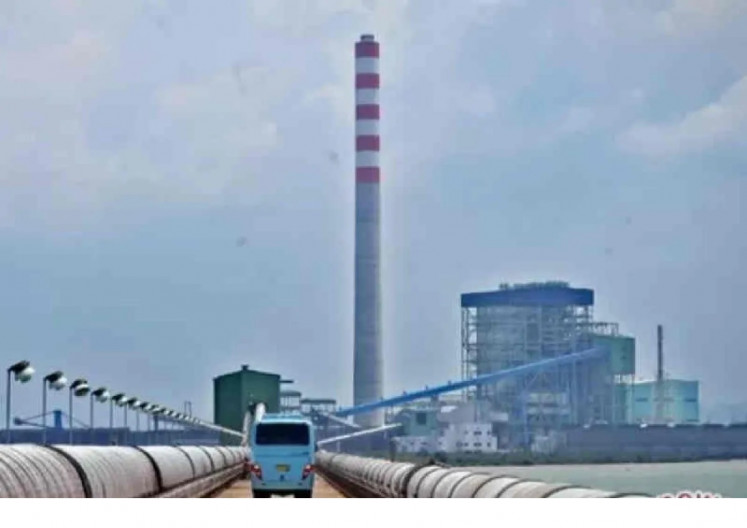Popular Reads
Top Results
Can't find what you're looking for?
View all search resultsPopular Reads
Top Results
Can't find what you're looking for?
View all search resultsPECC: China could sustain 7 percent growth for 10 to 20 years
Regional update: The Jakarta Post Digital CEO Judistira Wanandi (third left) shares a light moment with participants of the seminar “Global Challenges and Regional Solutions: Engaging Stakeholders” organized by The Jakarta Post and the Pacific Economic Cooperation Council (PECC) in Jakarta on Monday
Change text size
Gift Premium Articles
to Anyone
R
span class="caption">Regional update: The Jakarta Post Digital CEO Judistira Wanandi (third left) shares a light moment with participants of the seminar “Global Challenges and Regional Solutions: Engaging Stakeholders” organized by The Jakarta Post and the Pacific Economic Cooperation Council (PECC) in Jakarta on Monday.(JP/Wienda Parwitasari)
China, an expert claims, is likely to record annual growth of 7 percent for the next 10 to 20 years despite suffering an ongoing cyclical slowdown and it taking a while for the world’s second-largest economy to bounce back.
The rather optimistic forecast was aired by Fan Gang, director of the China Reform Foundation National Economic Research Institute, who has gone against the consensus view that the slowdown is likely to worsen in the future.
Fan was adamant that the current growth could be sustained for the next 10 to 20 years despite China having experienced rapid growth leading to overheating, overinvestment and over capacity.
“The major problems are: over-capacity, debts, struggling companies, deflation [...] typical problems during the down turn of a business cycle, after two cases of overheating in 2004-2007 and 2009-2010,” Fan told a seminar in Jakarta on Monday.
“Therefore, the cyclical issues are important to understand the situation, in addition to long-term factors such as institutional or structural factors.”
With the theme “Global Challenges and Regional Solutions: Engaging Stakeholders”, the seminar was jointly held by The Jakarta Post and the Pacific Economic Cooperation Council to commemorate the Post’s 33rd anniversary.
While China is ASEAN’s growth motor, being the grouping’s largest trading partner and the key investors for several, if not all, member states, the East Asian giant suffered its weakest full-year growth in 26 years at 6.9 percent in 2015, although the figure was in line with the Chinese government’s prediction of 7 percent growth. Industrial production, retail sales and fixed-asset investment all slowed at the end of 2015, Bloomberg reported.
People would prefer a managed adjustment process, or a “soft-landing”, to ensure that China is able to control a bubble burst. An adjustment process would prevent the economy from overreacting and avoid a great recession, Fan said, but it may take a long time to finish the cycle. In the overheating of the 1990s, he said, it took China eight years to recover.
Two issues received most attention in terms of China’s management of its landing: government debt and the housing market. Bad debts in China’s banking industry jumped by 51 percent last year to 1.27 trillion yuan (US$195.57 billion), a report by Bloomberg stated.
While there was mismatched investment needs and lending terms, Fan asserted that Chinese government debt would not lead to a financial meltdown.
The overall government debt-to-GDP ratio is still about 50 percent and is still among the lowest in the world, he said, adding that swaps for public bonds could also reduce risk for financial sectors. “The risks will be very much managed,” he said.
While the gap between supply and demand in the Chinese real estate market has led to fears of another bubble, there has been tightening in the industry that will not lead to a hard landing after economic adjustments, Fan said.
The key for growth, he continued, would be an increased labor supply with a new wave of urbanization — as most Chinese workers, he said, were still in the agricultural sector — as well as institutional and financial reforms.
Masahiro Kawai from the University of Tokyo says that high expectations might lead to steep disappointment, and what was urgent for China was avoiding overcapacity issues.
He added that people did not want to see rapid depreciation of the yuan like last year, possibly triggering a currency war in the region.
The Chinese government loosened its pegged yuan in 2015, hoping to see the currency listed in the International Monetary Funds’ (IMF) leading currencies. The move terrified commodity-based economies who feared the move might make Chinese exports more competitive while at the same time inflating prices of imported goods, deterring Chinese consumers from buying them.
Kawai disagreed with Fan, saying China might experience slower growth in the next 10 to 20 years and not higher.
“China is in the middle of structural change and potential growth is slowing down to 6 percent [or] to 5 percent in the next 10 to 20 years, which is quite natural for a rapidly growing economy,” he said.
Lee Jae Yong, leading economist of the ASEAN+3 Macroeconomic Research Office (AMRO), said that structural reform was needed to address the global slowdown, where short-term challenges and long-term challenges were intertwining to make problems more complex.
While commodity prices create short term challenges, Lee said, declining GDP growth led to people questioning the need to buy, even when prices were low, thus making companies hesitant to invest.










